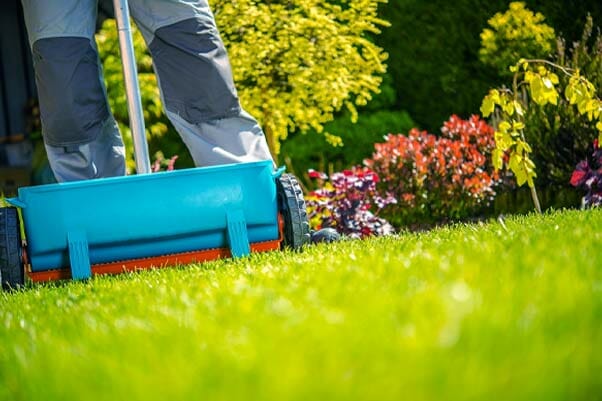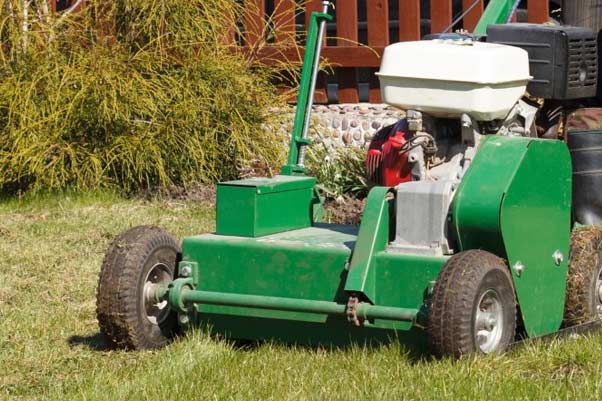Aeration plays a crucial role in maintaining a healthy lawn, as it involves creating holes in the soil to promote air, water, and nutrient flow to the roots.
Lawn aeration should be done every 1 – 2 years. Well-drained lawns with sandy soil can be done every 2 years, while lawns that are always trampled or compacted (foot-traffic, parked vehicles, etc), or with clay soil should be aerated annually.
Spiking or coring is the method used to aerate lawns. Spiking is a less invasive method of aerating your lawn, and it involves the use of solid tines to punch small holes in your lawn. Coring, on the other hand, utilizes hollow tines to puncture your lawn surface to extract a plug of soil from the ground which is dropped on the lawn to disintegrate.
Can you aerate your lawn too much?
Deciding how often to aerate is an issue for most people, and having an aerating timetable can help. Unless your lawn is heavily trodden or it’s fading in patches, you should be aerating your lawn on average – once every two years. It is not uncommon to see people who aerate several times a year end up with damaged soil. Frequent aeration will cause your soil to loosen, and leave your grass stressed.
Should I aerate my lawn every year?

A popular trend among homeowners is to aerate their lawns yearly. However, if your lawn is barely trodden on, and you have lush, healthy-looking grass. Then you’re better off aerating every two years. A heavily-trafficked lawn should be aerated annually. The two main factors determining your aeration schedule are your lawn compaction and its soil composition.
Lawn compaction
Compaction means a decline in the soil pore space. Typically, the soil on your lawn should be equal parts solid and porous. The pore space is the tiny holes in your lawn that channel air, water, and soil nutrients to the root level of your lawn grass. A 10% decrease in the spore space can be devastating to your grass because their roots will struggle to get nutrients from the soil, and they won’t grow deeper. If people walk across, or you park your car, or your children and their friends play on your lawn. Then your lawn needs to be aerated every year.
Soil composition
Clay soil compacts easily, unlike sandy or loam soils which are loose and have lots of oxygen filtering through them. Regular aeration of sandy and loam soils causes them to break loose and this can make your lawn soil unstable. However, clay soil compacts easily and it doesn’t have an even distribution of oxygen at the root level. This is bad for the health of your lawn grass. If the soil composition of your lawn is clay, then you’ll have to aerate every year.
What is the best time of year to aerate a lawn?

Timing your lawn aeration isn’t an exact science. It depends on certain factors such as; your type of lawn grass, and your local weather conditions. Executing a poorly timed aeration could have devastating consequences for your lawn, which could take a lot of effort and money to undo.
The type of lawn grass you have will determine when you should aerate. There is no exact time, but popular opinion among lawn keepers indicates that the best time of the year to aerate is early fall and early spring. But as an individual homeowner, the best time for you to aerate is during the periods when your local weather conditions permit the rapid growth of new plant life. Avoid aerating right after unusually hot or dry periods to avoid placing additional stress on your lawn grass.
There are two categories of lawn grass; cool-season grass, and warm-season grass. Both grass types have different aerating timelines which when adhered to, will retain the health and beauty of your lawn.
● Cool-seasons
Lawns with cool-season grass should be aerated in the fall for best results. Nevertheless, homeowners living in warmer locations may prefer to aerate their cool-season grass lawns in early spring. It is recommended that you aerate in early fall to give your lawn enough time to recover before winter dormancy. Types of cold-weather grass include ryegrass, bluegrass, and fescue.
● Warm-seasons
Aeration for lawns that have warm-season grass should take place during the period between late-spring and early-autumn. This process must occur after your lawn has been cut a few times. Doing this will stimulate the lawn grass to grow rapidly, ensuring that your lawn benefits from the high pore space and air circulation created at the root zone by the aeration process. Types of warm-season grass include; Bermudagrass, buffalograss, St. Augustine, and zoysiagrass.
Is lawn aeration important?
Aeration improves soil quality, and it can revive infected lawns. It is a cheap lawn maintenance technique that compliments your extra yard keeping efforts with fabulous results.
The importance of aerating your lawn is wide and varied, here are a few:
- Aerating keeps your lawn healthy and green.
- Water and soil nutrients push deeper into the ground as a result of aeration, reaching the roots in the soil and allowing for healthier lawn grass.
- The lawn becomes more drought resistant as they grow deeper roots beneath the ground surface due to the increase in the soil pores.
- Aerating enables oxygen and fertilizer to sink deeper into the ground where the roots can access them allowing for a more luxuriant lawn.
- Aerating gives you a twofold advantage; it prevents water runoff by enabling the water to penetrate deeper into the lawn, which reduces your lawn watering costs.
FAQ's
Should I fertilize after lawn aeration?
You can fertilize your lawn immediately after aerating. Pores created in the soil after aerating allow greater access for fertilizers, air, water, and other nutrients to reach the root level allowing lawn grass to grow deeper roots in the soil. The outcome is a healthy, disease, and drought-resistant lawn.
What is the best way to aerate a lawn?
Core aeration – is the best method of aeration, and it works best for long-term results. It is an invasive procedure that utilizes hollow tines that penetrate your lawn to extract cylindrical plugs of soil from the ground. The hollow tines leave holes or pores in the lawn through which air, water, and topsoil nutrients enter the soil and stimulate the growth of lawn grass. The cylindrical plugs extracted from the ground are left on your lawn which breaks down aiding the growth process. This is the aerating method preferred by professionals.
Spike aeration – is a less-invasive aeration method that produces short-term results. It is done by simply poking a hole down into the soil with a solid, spike-like tine. However, this method can be counterproductive because it creates more soil compaction. When pushed into the soil, the spike aerator will push the soil beneath further Into the ground, and to the sides. Despite its shortcomings, the spike aerator is an ideal DIY tool for small yard work by homeowners.
How much does lawn aeration cost?
Spike aeration
It’ll cost you nothing to aerate your lawn if you decide to DIY using this method. A pitchfork or spading fork is sufficient as a quick backyard aerator. Lawn aerator spike shoes cost around $26 should you decide to shell out extra for specialist equipment.
Core aeration.
Professional lawn keepers won’t even give you an estimate for spike aeration, so you’re stuck with core aeration should you choose this route. You can expect to pay around $15 to $17 per thousand square feet if you are using a lawn care company.
The average lawn size in the USA is 10,000 square feet, so you can expect to pay $150 – $170.
Should I DIY lawn aeration? Is it cheaper?
Aeration isn’t just about making holes in the ground. It requires that you have significant experience in lawn maintenance techniques and good knowledge of your lawn layout. Cutting a hole in an underground utility line will result in costly repairs. So it’s best if you’re careful.
To do a great job, you’ve got to have the right tools. You can rent an aerating machine for almost the same price you would pay a professional to do the job. Also, think of the time you’ll spend working on your lawn. A major benefit of aerating your lawn is that you’ll be working outdoors, taking care of something you love.
Can I overseed without aeration?
You can simply overseed your lawn if you want to introduce new grass without going to the trouble of aeration. The best time to overseed your lawn is during the late growing season.






